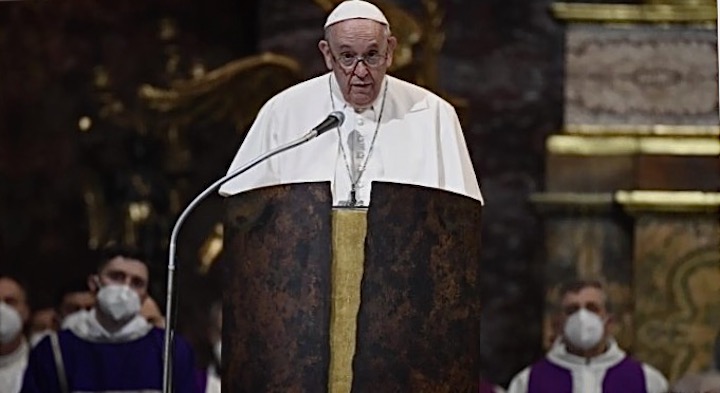On March 12, Pope Francis went to the Jesuit Church of the Gesú in Rome for a Mass on the occasion of the 400th anniversary of the canonizations of St. Ignatius Loyola and St. Francis Xavier. The pope preached at the Mass and concelebrated. He had earlier been scheduled to be the principal celebrant, but Fr. Arturo Sosa, S.J., Superior General of the Society of Jesus, for some reason, was the principal celebrant instead.
Liturgical theology and law do not countenance that a bishop, let alone the diocesan bishop in his own diocese, concelebrate Mass with a priest as the principal celebrant (apart from a grave necessity, such as infirmity). This flows from the nature of the episcopal office: the bishop is the high priest in his diocese. He offers the sacrifice of the Mass for his people, while his priests, co-workers who serve the local Church under his authority, concelebrate with him.
The Mass began with the usual entrance procession. Pope Francis was already seated in a chair near the altar. He wore no liturgical vestments, and thus gave no indication that he was either concelebrating or presiding. He preached without wearing the liturgical garments (mozetta, rochet, and stole) that are prescribed to be worn when the preacher is not the one celebrating the Mass.
He concelebrated, extending his hand and saying the words of consecration, without wearing Mass vestments (alb, stole, and chasuble). This practice is strictly forbidden. In its 2004 Instruction Redemptionis Sacramentum, the Congregation for Divine Worship stated: “The abuse is reprobated whereby the sacred ministers celebrate Holy Mass or other rites without sacred vestments.”
Is the pope subject to liturgical law? Yes. Can he dispense himself from liturgical laws? Yes, but canon 90 states that there must be “a just and reasonable cause” for a dispensation. Did Pope Francis canonically dispense himself from the requirement to wear liturgical vestments when preaching at and concelebrating Mass? He may have, but the Holy See has given no indication that he in fact did so.
Was there a just and reasonable cause for the pope not to wear the prescribed liturgical vestments? It is very difficult, if not impossible, to assert that such a cause existed in this case.
We are confronted here with a reality that Catholics are all too familiar with in the life of the Church during the past half-century and more – the flagrant flouting of liturgical laws for no apparent reason beyond the preference of the priest celebrant.
Is this an important matter? For some, undoubtedly, such liturgical abuses are insignificant and do not merit any comment. Some will say that the pope can do whatever he wants, and we should not be upset over this or that choice of his: “He must have a good reason, and it is impertinent to question his judgment, because, after all, he is the pope.”

But it is precisely because he is the pope that we should be concerned about his decision to disregard the rules governing the celebration of Mass. The pope is the supreme authority in the Church and as such is called upon to uphold the Church’s laws, lest he scandalize the faithful by giving a bad example. The scandal would consist in giving the impression that, following the example of the pope, any priest is perfectly free to do whatever he wants when it comes to following liturgical law.
It’s no secret that many Catholics have flocked to the celebration of the Traditional Latin Mass because they are tired of the widespread liturgical abuses they encounter in the celebration of the New Mass. Pope Francis himself is aware of this.
He brought up this problem in his July 16, 2021 letter to the bishops of the world accompanying Traditionis Custodes, his motu proprio restricting the celebration of the Old Mass: “I am saddened by abuses in the celebration of the liturgy on all sides. In common with Benedict XVI, I deplore the fact that ‘in many places the prescriptions of the new Missal are not observed in celebration, but indeed come to be interpreted as an authorization for or even a requirement of creativity, which leads to almost unbearable distortions.’”
He counseled the bishops: “I ask you to be vigilant in ensuring that every liturgy be celebrated with decorum and fidelity to the liturgical books promulgated after Vatican Council II, without the eccentricities that can easily degenerate into abuses.”
Pope Francis’ own words serve as a rebuke of his decision to concelebrate Mass without liturgical vestments. The sacred character of our acts of worship is fostered and protected when priests and bishops willingly and carefully follow the requirements of liturgical law. The Christian faithful have the right to participate in liturgical prayer without being compelled to experience “unbearable distortions” of good liturgical order. That right depends upon the willingness of priests and bishops to obey what is set down in liturgical law.
There is no clerical privilege that allows priests and bishops to rewrite the rules to suit their own tastes. Yet that is precisely what some priests and bishops will sadly take away from this regrettable instance of papal liturgical abuse.
The worship of God is the sacred duty of the Church’s pastors. The form of that worship is given to them by the Church. It is their responsibility to see to it that every act of liturgical worship is carried out in loving fidelity to what is set forth by the Church in her liturgical laws. Disobedience teaches the wrongful lesson that Church law is unimportant.
This is a recipe for more chaos in the life of the Church. It needs to stop.
*Image: Pope Francis, unvested, at the March 12, 2022 canonization anniversary Mass.
You may also enjoy:
Robert Royal’s Ever Ancient, Ever New
Fr. Thomas G. Weinandy’s Note on his letter to Pope Francis














